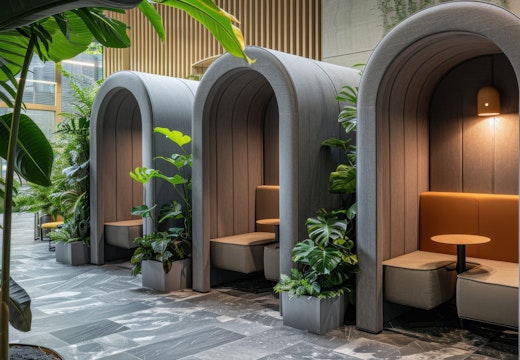Standing up for change: why an active workplace makes a difference
Research shows that supporting people to be more active in the workplace brings health and productivity benefits to the organisation. Is it time to activate the office?
As wellness programmes flood offices, some good old-fashioned ways to improve worker health are getting less attention. One of the design opportunities fading out of view is creating work environments where people are physically more active — research shows that workplaces where people are more active can elevate mental and physical health as well as professional performance.
A new study by a Canadian research team (Pearse and colleagues 2024) has found via a review of previously published studies that ‘prolonged sitting is associated with several negative adverse health effects, affecting the physical, physiological and cognitive systems.’ Movement throughout the day helps negate these health effects.
The study advocates for combining the use of ‘active chairs’ with a sit-to-stand workstation to help reduce sedentary behaviour at the workplace. Active chairs are described as ‘designed so that the sitter is providing the action to move the chair [for example, its seat pan], while the mechanism of the chair accommodates that action.’
Building on research
This new study, Journal of Bodywork and Movement Therapies, builds on previous research in the field.
In 2023, for example, DiRocco and colleagues evaluated, via a survey, when people were more likely to sit or stand to work. They reported that ‘there were differences between actual and preferred behaviour for each position, with participants sitting more and standing less than preferred across all task categories.’ There were differences between task categories with participants sitting less for generative and routine tasks, and standing more for communication tasks.
Engineers reported the lowest standing rates in the DiRocco -led study, and also indicated standing more than preferred. Finance reported the highest sitting rates. Office workers generally would prefer to stand more at work.
Activity levels at work can be increased through furnishings such as sit-stand desks and also via the design of circulation spaces. Indoor galleries, particularly if they include large windows that provide views outdoors or art, for example, may encourage some people to hold walking meetings instead of seated ones. There can also be some functional inconveniences built into floorplans, such as a longer-than-needed route to the cafeteria, to get people moving—although any extra-long routes must be paired with more direct options for people who find it inconvenient to use them (for example, because of a recent sports injury).
Active circulation
When designing circulation routes, it can be handy to know, for instance, that:
- People are drawn toward warm colours (Bellizzi, Crowley, and Hasty, 1983) so they’re good options for walls when you want to lead people in a particular direction, say to the end of a long hallway or toward a reception desk.
- People choose to walk in more brightly lit areas and are drawn toward bright lights (Taylor and Sucov, 1974). If the edges of hallways are brighter than their middles, people will likely walk at those edges, which can be handy if a hallway might be a little narrow.
- Gently curving hallways are biophilic in form and encourage us to continue to travel forward (Joye, 2007).
- We tend to continue to walk on the same sort of flooring – we’ll keep on a carpeted or hardwood floor path, for instance (Bitgood, 2011).
Benefits of active design
All the effort to encourage people to be active at work is worth it because:
- Cognitive performance improves when people are walking at their own pace (Schaeffer, Lovden, Wieckhorst, and Lindenberger, 2010) and immediately after they walk (for example, Salas, Minakata, and Kelemen, 2011).
- Walking, and having walked recently (say in the last 10 to 20 minutes or so) boosts creativity (Oppezzo and Schwartz, 2014; Murali and Handel, 2022). Rominger and teammates (2020) found that ‘creativity, positive-activated affect [mood], and everyday bodily movement were associated with each other’.
- Webb and teammates (2017) learned that ‘both alone and in combination with its effects on mood and stress, walking can encourage individual mindsets conducive to resolving conflict’.
- After white collar workers work out in on-site exercise facilities, their moods and their professional performance improve (Coulson, McKenna and Field, 2008).
- Simply standing is good for our cognitive performance (for example, Bhat, Dehury, Chandrasekaran, Palanisamy and Arumugam, 2022).
- Colenberg, Jylha, and Arkesteijn (2021), after a literature review, report that ‘features that encourage physical activity, including sit-stand and bike desks, and increased distances to communal facilities, are found to have a positive relationship with physical wellbeing.’
Read more of the latest research insights from Sally Augustin in Research Roundup, her regular column in the Innovation Zone for WORKTECH Academy members and partners here.
Research sources
Joseph Bellizzi, Ayn Crowley, and Ronald Hasty. 1983. ‘The Effects of Color in Store Design.’ Journal of Retailing, vol. 59, pp. 21-45.
Mayur Bhat, Keshab Dehury, Baskaran Chandrasekaran, Hari Palanisamy, and Ashokan Arumugam. 2022. ‘Does Standing Alter Reaction Times and Event Related Potentials Compared to Sitting in Young Adults? A Counterbalanced, Crossover Trial.’ Theoretical Issues in Ergonomics Science, vol. 23, no. 6, pp. 663-686.
Stephen Bitgood with contributions from others. 2011. Social Design in Museums: The Psychology of Visitor Studies. Museums Etc.: Edinburgh.
Susanne Colenberg, Tuuli Jylha, and Monique Arkesteijn. 2021. ‘The Relationship Between Interior Office Space and Employee Health and Well-Being – A Literature Review.’ Building Research and Information, vol. 49, no. 3, pp. 352-366.
Coulson, J. McKenna, and M. Field. 2008. ‘Exercising at Work and Self-Reported Work Performance.’ International Journal of Workplace Health Management, vol. 1, no. 3, pp. 176-197.
Tara DiRocco, Brianna Hall-Nelson, Ingrid Carlson, John Corrigan, Stephanie Kutcher, Patrick Mertz, and Erika Nelson-Wong. 2023. ‘Task Type, Preference, and Occupational Affect Standing Desk Utilization in Office Workers.’ Work, vol. 74, no. 1, pp. 295-308.
Yannick Joye. 2007. ‘Architectural Lessons From Environmental Psychology: The Case of Biophilic Architecture.’ Review of General Psychology, vol. 11, no. 4, pp. 305-328.
Supriya Murali and Barbara Handel. 2022. ‘Motor Restrictions Impair Divergent Thinking During Walking and During Walking and During Sitting.’ Psychological Research, vol. 86, pp. 2144-2157.
Marily Oppezzo and Daniel Schwartz. 2014. ‘Give Your Ideas Some Legs: The Positive Effect of Walking on Creative Thinking.’ Journal of Experimental Psychology: Learning, Memory, and Cognition, vol. 40, no. 4, pp. 1142-1152.
Steve Pearse, Michelle Leger, Wayne Albert, and Michelle Cardoso. 2024. ‘Active Workstations: A Literature Review on Workplace Sitting.’ Journal of Bodywork and Movement Therapies, vol. 38, pp. 406-416.
Christian Rominger, Andreas Fink, Bernhard Weber, Ilona Papousek, and Andreas Schwerdtfeger. 2020. ‘Everyday Bodily Movement is Associated With Creativity Independently from Active Positive Affect: A Bayesian Mediation Analysis Approach.’ Nature Scientific Reports, vol. 10, 11985.
Carlos Salas, Katsumi Minakata, and William Kelemen. 2011. ‘Walking Before Study Enhances Free Recall But Not Judgment-of-Learning Magnitude.’ Journal of Cognitive Psychology, vol. 23, no. 4, pp. 507-513.
Sabine Schaeffer, Martin Lovden, Birgit Wieckhorst, and Ulman Lindenberger. 2010. ‘Cognitive Performance is Improved While Walking: Differences in Cognitive-Sensorimotor Couplings Between Children and Young Adults.’ European Journal of Developmental Psychology, vol. 7, no. 3, pp. 371-389.
Lyle Taylor and Eugene Sucov. 1974. ‘The Movement of People Toward Lights.’ Journal of IES, pp. 237-241.
Christine Webb, Maya Rossignac-Milon, and E. Higgins. 2017. ‘Stepping Forward Together: Could Walking Facilitate Interpersonal Conflict Resolution?’ American Psychologist, vol. 72, no. 4, pp. 374-385.








